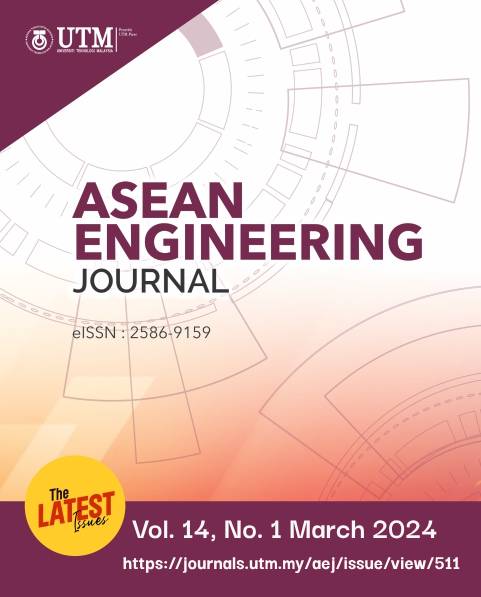MONITORING THE ABSENCE OF QUEEN BEE IN THE HIVE USING DEEP LEARNING AND HILBERT HUANG TRANSFORM
DOI:
https://doi.org/10.11113/aej.v14.20163Keywords:
Hilbert Huang transform, Internet of things, Support vector machine, Deep learning neural networksAbstract
In this paper, we present a fusion method to monitor the absence of the queen bee in a hive using a combination of deep learning neural networks, support vector machine (SVM), and Hilbert Huang transform. First, we collect the sound data from the hive in the presence and missing of the queen bee using the Internet of Things system (IoT). Next, we slice the received audio signal into small chunk with a duration of 10 seconds. In the next step, we perform the Hilbert Huang Transform on each chunks to obtain the spectral image of the audio signal with and without the queen bee. Finally, we use the obtained spectral images to train and test the deep learning neural networks model combined with a support vector machine (SVM) to classify the spectral image of the audio signal with and without the queen bee. The test results on the test set achieved a classification accuracy of 98.61%.
References
Ratnieks, F.L.: 1993. Egg-laying, egg-removal, and ovary development by workers in queen right honey bee colonies. Behavioral Ecology and Sociobiology 32(3): 191–198. DOI: https://doi.org/10.1007/BF00173777
S. Ntalampiras, I. Potamitis, and N. Fakotakis: 2012, Acoustic detection of human activities in natural environments. Journal of the Audio Engineering Society 60(9): 686–695.
H. Frings and F. Little: 1957. Reactions of honey bees in the hive to simple sounds. Science 125(3238): 122–125. DOI: 10.1126/science.125.3238.122
A. Michelsen, W. H. Kirchner, and M. Lindauer: 1986. Sound and vibrational signals in the dance language of the honeybee, apis mellifera. Behavioral Ecology and Sociobiology 18(3): 207–212. DOI: https://doi.org/10.1007/BF00290824
W. H. Kirchner: 1993. Acoustical communication in honeybees. Apidologie 24(3): 297–307. DOI: https://doi.org/10.1051/apido:19930309
M. Hrncir, F. G. Barth, and J. Tautz: 2006. Vibratory and airborne sound-signals in bee communication. CRC Press: 421–436.
J. H. Hunt and F. J. Richard: 2013. Intracolony vibroacoustic communication in social insects. Insectes Sociaux 60: 403–417. DOI: https://doi.org/10.1007/s00040-013-0311-9
Bromenschenk, J., Henderson, C., Seccomb, R., Rice, S., Etter, R.: 2007. Honey Bee Acoustic Recording and Analysis System for Monitoring Hive Health. U.S. Patent 7549907B2
T. Cejrowski, J. Szymanski, H. Mora, and D. Gil: 2018. Detection ´ of the bee queen presence using sound analysis. Intelligent Information and Database Systems 10752: 297– 306. DOI: https://doi.org/10.1007/978-3-319-75420-8_28
A. Robles, T. Saucedo-Anaya, E. Gonzlez-Ramrez, and C. Galvn Tejada: 2017. Frequency analysis of honey bee buzz for automatic recognition of health status: A preliminary study. Research in Computing Science 142(1): 89–98. DOI: https://doi.org/10.13053/rcs-142-1-9
D.G. Dietlein: 1985. A method for remote monitoring of activity of honeybee colonies by sound analysis. Journal of Apicultural Research 24(2): 176 183. DOI: https://doi.org/10.1080/00218839.1985.11100668
S. Ferrari, M. Silva, M. Guarino, and D. Berckmans: 2006. Monitoring of swarming sounds in bee hives for prevention of honey loss. International Workshop on Smart Sensors in Livestock Monitoring.
S. Ferrari, M. Silva, M. Guarino, and D. Berckmans: 2008. Monitoring of swarming sounds in beehives for early detection of the swarming period. Computers and Electronics in Agriculture 64(1): 72–77. DOI: https://doi.org/10.1016/j.compag.2008.05.010
A. Qandour, I. Ahmad, D. Habibi, and M. Leppard: 2014. Remote beehive monitoring using acoustic signals. Acoustics Australia / Australian Acoustical Society 42(3): 204–209.
Tymoteusz Cejrowski, Julian Szymański, Higinio Mora, David Gil: 2018. Detection of the Bee Queen Presence Using Sound Analysis. Intelligent Information and Database Systems 10752: 297-306. DOI: https://doi.org/10.1007/978-3-319-75420-8_28
Larissa Chazette, Matthias Becker, Helena Szczerbicka: 2016. Basic algorithms for bee hive monitoring and laser-based mite control. 2016 IEEE Symposium Series on Computational Intelligence: 1-8. DOI: 10.1109/SSCI.2016.7850001
Vladimir Kulyukin, Sarbajit Mukherjee, Prakhar Amlathe: 2018, Toward Audio Beehive Monitoring: Deep Learning vs. Standard Machine Learning in Classifying Beehive Audio Samples. Applied Sciences 8(9): 1573. DOI: https://doi.org/10.3390/app8091573
P. Mekha, N. Teeyasuksaet, T. Sompowloy and K. Osathanunkul: 2022. Honey Bee Sound Classification Using Spectrogram Image Features. 2022 Joint International Conference on Digital Arts, Media and Technology with ECTI Northern Section Conference on Electrical, Electronics, Computer and Telecommunications Engineering: 205-209. DOI: https://doi.org/10.1109/ECTIDAMTNCON53731.2022.9720352
Agnieszka Orlowska, Dominique Fourier, Jean-Paul Gavini, Dominique Cassou-Ribehart: 2021. Honey Bee Queen Presence Detection from Audio Field Recordings using Summarized Spectrogram and Convolutional Neural Networks. 21st International Conference on Intelligent Systems Design and Applications: 83–92. DOI https://doi.org/ff10.1007/978-3- 030-96308-8_8ff. ffhal-03439646.
Shah Jafor Sadeek Quaderi, Sadia Afrin Labonno, Sadia Mostafa, Shamim Akhter: 2022. Identify the beehive sound using deep learning. International Journal of Computer Science & Information Technology 14(4): 13-29. DOI: https://doi.org/10.5121/ijcsit.2022.14402.
Hien Nguyen Thi, Thi Thu Hong Phan, Cao Truong Tran: 2023. Genetic Programming for Bee Audio Classification. 8th International Conference on Intelligent Information Technology: 246–250. DOI: https://doi.org/10.1145/3591569.3591612.
Kiromitis I. Dimitrios, Christos V. Bellos, Konstantinos A. Stefanou, Georgios S. Stergios, Ioannis Andrikos, Thomas Katsantas, Sotirios Kontogiannis: 2022. Performance Evaluation of Classification Algorithms to Detect Bee Swarming Events Using Sound. Signals 3(4): 807-822. DOI: https://doi.org/10.3390/signals3040048.
Jaehoon Kim, Jeongkyu Oh, Tae-Young Heo: 2021. Acoustic Scene Classification and Visualization of Beehive Sounds Using Machine Learning Algorithms and Grad-CAM. Mathematical Problems in Engineering 2021: 1-13. DOI: https://doi.org/10.1155/2021/5594498.
Thi Thu Hong Phan, Dong Nguyen Doan, Du Nguyen Huu, Hanh Nguyen Van, Thai Pham Hong: 2022. Investigation on new Mel frequency cepstral coefficients features and hyper-parameters tuning technique for bee sound recognition. Application of soft computing 27: 5873–5892. DOI: https://doi.org/10.1007/s00500-022-07596-6
N. E. Huang, S. P. Shen: 2005. Hilbert-Huang Transform and Its Application. Interdisciplinary Mathematical Sciences 5: 1-324. DOI: https://doi.org/10.1142/58625
















